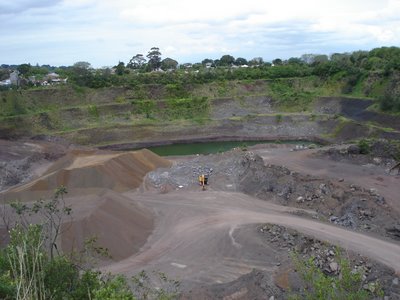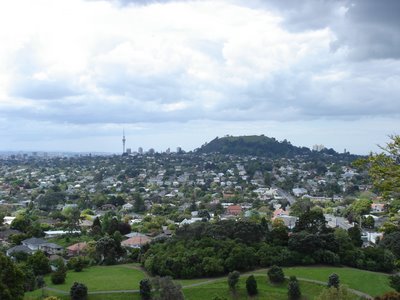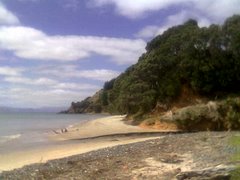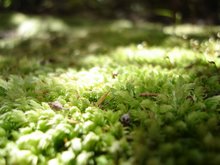Today we headed north, along
State Highway One, past
Orewa, and then
Waiwera, to sunny
Wenderholm and it's Regional Park. As with
Cascades Kauri Regional Park, the walks here are well organised - with a useful map at the start of the tracks which takes you through the options, including which are suitable for buggies (or not ok for jandals). The tracks are clearly sign-posted throughout, for the most part, and when it might get confusing, with a number of tracks converging, their are colour-coded posts to help. Big ups to the
ARC.We picked the
Perimeter Track, recommended in our
Day Walks of Auckland book. This involved a lot of up at the start, as we climbed
Maungatauhoro, a former pa site. The tracks up included a lot of steps and boardwalks, as well as several well placed lookouts and a chance to see an old midden (which rather reminded me of why I found archaeology so boring at university).
The views from Maungatauhoro were great, and luckily the weather just got better as the day progressed.
The start of the Puhoi river, below:

Looking east from the top:

Once you reach the top you can either walk back the way you came or take the tramping track down, which is largely unformed and would be very difficult in wet weather. We both had decent walking shoes so we headed down the tougher section, and the grips on my Tevas were indispensable.
Eventually we came out at
Kokoru Bay, where in a former life I once cleared some bush (for reasons unknown) during one of those pointless weeks at the end of Sixth Form. Nice view across the river to Waiwera itself.

However the noise from State Highway One is pretty full on from about half-way down the hill until the track stops following the road and turns back into the park around half an hour later. At one point there was a whole gaggle of loud motorbikes heading across the Waiwera bridge, and even though we were a considerable distance away the noise reverberated around the bush and disturbed the peace.
The bush is not as regenerated as at
Cascades Kauri, and I don't think I've ever seen so many nikaus in one place. Bird-wise we heard tui, saw piwakawaka (fantails), and of course blackbirds and thrush. My moss obsession continued.

Almost the entire walk is through bush cover, until you start walking back to the carparks, along the road into the park itself. Here there are cows and sheep, not to mention a really large number of ducks. Before heading back to the car, after about an hour and a quarter of walking, we decided to have a quick squizz at
Couldrey House.
Lovely spot, unfortunately it was $2 each to go in, which is fine except when you don't have any cash on you.
Then we decided to walk back to our vehicle along the beach. In a vain attempt to extend the tan on my feet beyond the patches my sandals expose I took my Tevas off, forgetting how hot the sand can get on a sunny day. The beach and picnic areas were being well used, and we spotted some oystercatchers on the sand, and of course the ubiquitous gulls.


Great set-up, interesting walk with information points along the way, definitely keen to come back and do some of the other tracks in the area, particularly
the Puhoi walk which includes the pa area itself.
(Pictures added 7th Dec)




 The Tramline Society's mini train - stopped at Picnic Flats when we came across it.
The Tramline Society's mini train - stopped at Picnic Flats when we came across it.


 The West Tunnel track was pretty muddy in parts, and at one point, where we had to cross a stream, it was very difficult to work out where the track went next. There's evidence that the ARC is starting to put boardwalks through, but the work is only just begun and at the moment the track is quite a challenge in parts.
The West Tunnel track was pretty muddy in parts, and at one point, where we had to cross a stream, it was very difficult to work out where the track went next. There's evidence that the ARC is starting to put boardwalks through, but the work is only just begun and at the moment the track is quite a challenge in parts. 

 Looking east from the top:
Looking east from the top: Once you reach the top you can either walk back the way you came or take the tramping track down, which is largely unformed and would be very difficult in wet weather. We both had decent walking shoes so we headed down the tougher section, and the grips on my Tevas were indispensable.
Once you reach the top you can either walk back the way you came or take the tramping track down, which is largely unformed and would be very difficult in wet weather. We both had decent walking shoes so we headed down the tougher section, and the grips on my Tevas were indispensable. However the noise from State Highway One is pretty full on from about half-way down the hill until the track stops following the road and turns back into the park around half an hour later. At one point there was a whole gaggle of loud motorbikes heading across the Waiwera bridge, and even though we were a considerable distance away the noise reverberated around the bush and disturbed the peace.
However the noise from State Highway One is pretty full on from about half-way down the hill until the track stops following the road and turns back into the park around half an hour later. At one point there was a whole gaggle of loud motorbikes heading across the Waiwera bridge, and even though we were a considerable distance away the noise reverberated around the bush and disturbed the peace. Almost the entire walk is through bush cover, until you start walking back to the carparks, along the road into the park itself. Here there are cows and sheep, not to mention a really large number of ducks. Before heading back to the car, after about an hour and a quarter of walking, we decided to have a quick squizz at Couldrey House.
Almost the entire walk is through bush cover, until you start walking back to the carparks, along the road into the park itself. Here there are cows and sheep, not to mention a really large number of ducks. Before heading back to the car, after about an hour and a quarter of walking, we decided to have a quick squizz at Couldrey House. Lovely spot, unfortunately it was $2 each to go in, which is fine except when you don't have any cash on you.
Lovely spot, unfortunately it was $2 each to go in, which is fine except when you don't have any cash on you.
 Great set-up, interesting walk with information points along the way, definitely keen to come back and do some of the other tracks in the area, particularly the Puhoi walk which includes the pa area itself.
Great set-up, interesting walk with information points along the way, definitely keen to come back and do some of the other tracks in the area, particularly the Puhoi walk which includes the pa area itself.
 On top of Mt Victoria is a weather station, and a field of airvents decorated as mushrooms. The weather station reminds me vaguely of the Empire's probe on Hoth.
On top of Mt Victoria is a weather station, and a field of airvents decorated as mushrooms. The weather station reminds me vaguely of the Empire's probe on Hoth.

 We then headed down Mt Victoria, following the road, then headed up Kerr Rd, along St Aubyn's, left down Church, and into the Mt Cambria Reserve. Most of the time we walked between Mt Victoria and North Head we seemed to be on the Walking School Bus route for Devonport School:
We then headed down Mt Victoria, following the road, then headed up Kerr Rd, along St Aubyn's, left down Church, and into the Mt Cambria Reserve. Most of the time we walked between Mt Victoria and North Head we seemed to be on the Walking School Bus route for Devonport School: Mt Cambria isn't really a mountain, or even a hill. Maybe it was quarried away, there's certainly a lot of stone used in walls around the area. Whatever, it's really just a slight rise, topped by this lookout.
Mt Cambria isn't really a mountain, or even a hill. Maybe it was quarried away, there's certainly a lot of stone used in walls around the area. Whatever, it's really just a slight rise, topped by this lookout. The reserve itself includes the Devonport Museum (which was closed) and the walks within it are well laid out although neglected.
The reserve itself includes the Devonport Museum (which was closed) and the walks within it are well laid out although neglected.

 Then it was into the bush. Near the start of the walk we crossed a small river by wire suspension bridge.
Then it was into the bush. Near the start of the walk we crossed a small river by wire suspension bridge.  Then we generally wandered our way along the track, taking a few more pics along the way.
Then we generally wandered our way along the track, taking a few more pics along the way. Mostly of moss. I seemed to have rather the moss obsession today. But I'll only put up my favourite.
Mostly of moss. I seemed to have rather the moss obsession today. But I'll only put up my favourite. After a while there's a short track you can take to the falls themselves. Now we'd been pre-warned by the book that there wasn't much to see. It was a nice walk, with some really quite spectacular rock formations and overhangs (which didn't photograph well). But yes there was some disappointment at the end. Here's the view of the falls from the end of the track.
After a while there's a short track you can take to the falls themselves. Now we'd been pre-warned by the book that there wasn't much to see. It was a nice walk, with some really quite spectacular rock formations and overhangs (which didn't photograph well). But yes there was some disappointment at the end. Here's the view of the falls from the end of the track. If you squint you can just make out a little white bit in the middle of the shot. That's water rushing past.
If you squint you can just make out a little white bit in the middle of the shot. That's water rushing past. Then it was back to the main track.
Then it was back to the main track. 








